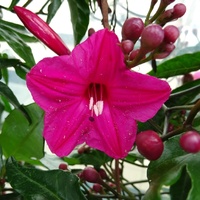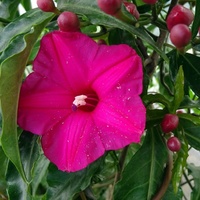Common name: Cardinal creeper
Other common names: Horsfall morning glory, Kuhio vine, Lady doorly's morning glory, Princess vine
Description
Cardinal creeper is a perennial flowering vine originating in the Caribbean. It is fast-growing, with vigorous, twining woody stems up to 10 m (33 ft) long and 1.5 cm (0.6 in) in diameter.
The leaves consist of three to five dark glossy green lance-shaped leaflets fused at the base, forming a star shape of variable size, their width ranging from 5 to 20 cm (2 to 8 in). For most of the year, they remain on the plant but with leaf-fall occurring in areas with a pronounced dry season.
The flowers are a large trumpet-shape, dark pink or red and bloom at their fullest in winter, with lighter blooms on and off at other times of the year.
Use
Cardinal creeper is usually trained to climb up on an arbour, trellis, fence or cascade over a wall where its showy flowers and foliage can be on their best display.
The flowers produce reasonable quantities of nectar, but not all of it is accessible to honeybees because of the flower's narrowing throat, which restricts the bee's access to it.
Climate
Grows naturally in moderately humid subtropical and tropical lowland to mid-elevation climates, generally areas with annual lows of 13 to 25°C, annual highs of 23 to 35°C, annual rainfall of 800 to 3000 mm and a dry season of 3 to 7 months.
Growing
New plants are produced using air-layering (circumposing) techniques or from suckers that sprout from underground tubers, part of the plant's root system. Cuttings are seldom used as they have a low success rate. Neither are seed, as seed-grown plants do not always inherit the characteristic of the parent.
Performs best on free-draining loam and sand soils of a moderately acid to slightly alkaline nature, generally with a pH of 5.5 to 7.5, and on sites with full to partial sun exposure. It has good tolerance to limestone soils, and plants grown in the shade may not flower to their fullest.
A vigorous vine, it needs a solidly built structure to support its weight as it grows.
Problem features
Reports on its weed risk are conflicting, and it is a declared noxious weed in at least one country. However, it is assessed as a low weed risk species for Hawaii and Florida, respectively, by the Hawaii Pacific Weed Risk Assessment (HPWRA) project and the IFAS Assessment of Non-Native Plants in Florida's Natural Areas (IFAS Assessment).
The tubers may eventually rise above soil level, so planting next to a path or wall should be avoided. The smothering of neighbouring plants is another problem that can result from its vigorous growth habit.
Where it grows
References
Books
-
Adams, C. D. 1972, Flowering plants of Jamaica, University of the West Indies, Mona, Greater Kingston
-
Bannochie, Iris, 1993. Gardening in the Caribbean. 1 Edition. Macmillan.
-
Burke, D. 2005, The complete Burke's backyard : the ultimate book of fact sheets, Murdoch Books, New South Wales, Australia
-
Griffiths, M. & Burras, J. K. 1994, Manual of climbers and wall plants, Royal Horticultural Society (Great Britain), Timber Press, Portland, Oregon
-
Mathias, M. E., 1982, Flowering plants in the landscape, University of California Press, Berkeley
-
Menninger, E. A. 1970, Flowering vines of the world : an encyclopedia of climbing plants, Hearthside Press, New York
-
Morton, J. F. 1971, Exotic plants, Golden Press, New York
-
Oakman, H. 1995, Harry Oakman's what flowers when : the complete guide to flowering times in tropical and subtropical gardens, University of Queensland Press, St. Lucia, Queensland
-
Rauch, F. D. & Weissich, P. R. 2000, Plants for tropical landscapes : a gardener's guide, University of Hawaii Press, Honolulu
Articles, Journals, Reports and Working Papers
-
Morton, J.F. 1964, Honeybee Plants of South Florida, Proceedings of the Florida State Horticultural Society, Vol 77:415-436.
-
Park Brown, S. G. & Knox, G. W. 2007. Circular 860. Flowering Vines for Florida. University of Florida, Gainesville: Env Hort Dept.



